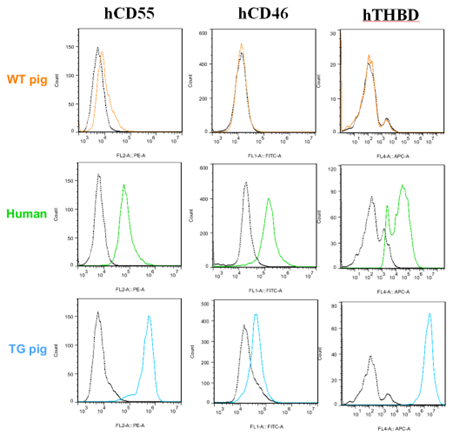Dengke Pan, People's Republic of China
Institute of organ transplantation
Preparation of GTKO/SdaKO/CMAHKO/hCD46/hCD55/hTHBD pig with high expression level of human CD55 through a transgene strategy
jiaxiang Du1, Hao Feng2, Gang Chen2, Yi Wang3, Dengke Pan1,4.
1Chengdu Sino-Clone Organ Biotechnology, Co., Ltd., Chengdu, People's Republic of China; 2Institute of Organ Transplantation,Tongji Hospital,Tongji Medical College, Huazhong University of Science and Technology, Wuhan, People's Republic of China; 3Department of Organ Transplantation, The Transplantation Institute of HainanMedical University, The Second Affiliated Hospital of Hainan Medical University, Hainan, People's Republic of China; 4Sichuan Key Laboratory of Clinical Immunological Translational Medicine, Sichuan Provincial People's Hospital, University of Electronic Science and Technology of China, Chengdu, People's Republic of China
Introduction: Modification of gene expression in the pig contributes to the long-term survival of pig organ grafts in monkeys. In addition to knockout of major xenoantigens, the expression of human complement regulatory proteins (hCRPs) is beneficial. The protective effect of hCRPs is related to their type and expression level. However, highly-expressed transgenes may be harmful to the health of the pig, e.g., by increasing the risk of infection risk (e.g., hCD46, which is a receptor for the measles virus). We prepared GTKO/SdaKO/CMAHKO/hCD46/hCD55/hTHBD pigs with high expression of hCD55.
Methods: Two vectors containing the same sequence of the hCD55 gene and promoter were constructed, one with and one without marker genes. The other vector elements, e.g., kozak, had minor differences in their sequences. First, the vectors were transferred into fibroblasts of identical GTKO pigs, and then two kinds of hCD55 pigs were prepared by somatic cell nuclear transfer. PBMCs were isolated from GTKO, GTKO/CD55#1, and GTKO/CD55#2 pigs. The expression of hCD55 in PBMCs was compared by flow cytometry. In addition, hCD55 expression levels in GTKO/SdaKO/CMAHKO/hCD46/hCD55/hTHBD pig endothelial cells and human endothelial cells were compared. PBMCs were incubated with human serum to detect the binding of antibodies. Complement-dependent cytotoxicity (CDC) tests were performed with rabbit complement and human complement. The binding of human complement C3, C4, and C5b-9 was measured when incubated with fresh human serum.
Results: CD55#1 pigs and CD55#2 pigs were produced with and without a marker gene, respectively. The expression level of the hCD55 protein on PBMCs in CD55#2 pigs was 8 times higher than that in CD55#1 pigs. The expression level of hCD55 in GTKO/SdaKO/CMAHKO/hCD46/hCD55/hTHBD pigs was 10 times higher than that of hCD55 on human endothelial cells (Figure1). All of these hCD55 pigs were healthy and had offspring.
Human antibody binding to PBMCs was similar in all pigs, but CDC was significantly different (P<0.01). CD55#2 showed better complement protection than CD55#1. The inhibitory effect of hCD55 on human complement was significantly stronger than on rabbit complement. After PBMCs were incubated with fresh human serum, the binding of human complement C3 and C5b-9 to hCD55 pig cells decreased significantly (P<0.01), with a greater decrease to CD55#2 cells than to CD55#1 cells (P<0.01).
Conclusions: The protective effect of hCD55 was related to its expression level, with a high level being associated with stronger protective function than a low level. Therefore, the quality and expression level of a transgene cannot be ignored. The gene-edited pigs chosen as sources of organs should focus on the protective effect of the transgenes, and not only on the number of transgenes inserted. The GTKO/SdaKO/CMAHKO/hCD46/hCD55/hTHBD pig should be a good ‘donor’ for clinical xenotransplantation.
Lectures by Dengke Pan
| When | Session | Talk Title | Room |
|---|---|---|---|
|
Thu-26 14:45 - 15:45 |
Donor genetic modification for xenotransplantation 1 | A transgenic strategy for hEPCR expression in porcine endothelial cells | Indigo D |
|
Fri-27 11:35 - 12:35 |
Donor genetic modification for xenotransplantation 2 | Preparation of GTKO/SdaKO/CMAHKO/hCD46/hCD55/hTHBD pig with high expression level of human CD55 through a transgene strategy | Indigo H |
